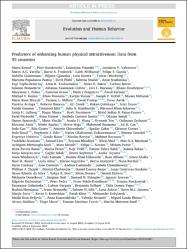Please use this identifier to cite or link to this item:
https://hdl.handle.net/20.500.11779/1845| Title: | Predictors of Enhancing Human Physical Attractiveness: Data From 93 Countries |
| Authors: | Sorokowski, Piotr Pisanski, Katarzyna V. Valentova, Jaroslava A.C.Varella, Marco A. Frederick, David Kowal, Marta Toplu-Demirtaş, Ezgi |
| Keywords: | Mating market perspective Social media usage Self-modification Appearance Evolutionary theory Pathogen stress |
| Publisher: | Elsevier |
| Source: | Kowal, M., Sorokowski, P., Pisanski, K., Valentova, J. V., Varella, M. A. C., Frederick, D. A., Al-Shawaf, L., García, F. E., Giammusso, I., Gjoneska, B., Kozma, L., Otterbring, T., Papadatou-Pastou, M., Pfuhl, G., Stöckli, S., Studzinska, A., Toplu-Demirtaş, E., Touloumakos, A. K., Bakos, B. E., & Batres, C. (6 September 2022). Predictors of enhancing human physical attractiveness: Data from 93 countries. Evolution and Human Behavior. pp. 1-20. https://doi.org/10.1016/j.evolhumbehav.2022.08.003 |
| Abstract: | People across the world and throughout history have gone to great lengths to enhance their physical appearance. Evolutionary psychologists and ethologists have largely attempted to explain this phenomenon via mating preferences and strategies. Here, we test one of the most popular evolutionary hypotheses for beauty-enhancing behaviors, drawn from mating market and parasite stress perspectives, in a large cross-cultural sample. We also test hypotheses drawn from other influential and non-mutually exclusive theoretical frameworks, from biosocial role theory to a cultural media perspective. Survey data from 93,158 human participants across 93 countries provide evidence that behaviors such as applying makeup or using other cosmetics, hair grooming, clothing style, caring for body hygiene, and exercising or following a specific diet for the specific purpose of improving ones physical attractiveness, are universal. Indeed, 99% of participants reported spending >10 min a day performing beauty-enhancing behaviors. The results largely support evolutionary hypotheses: more time was spent enhancing beauty by women (almost 4 h a day, on average) than by men (3.6 h a day), by the youngest participants (and contrary to predictions, also the oldest), by those with a relatively more severe history of infectious diseases, and by participants currently dating compared to those in established relationships. The strongest predictor of attractiveness-enhancing behaviors was social media usage. Other predictors, in order of effect size, included adhering to traditional gender roles, residing in countries with less gender equality, considering oneself as highly attractive or, conversely, highly unattractive, TV watching time, higher socioeconomic status, right-wing political beliefs, a lower level of education, and personal individualistic attitudes. This study provides novel insight into universal beauty-enhancing behaviors by unifying evolutionary theory with several other complementary perspectives. |
| URI: | https://hdl.handle.net/20.500.11779/1845 https://doi.org/10.1016/j.evolhumbehav.2022.08.003 |
| ISSN: | 1090-5138 |
| Appears in Collections: | Rehberlik ve Psikolojik Danışmanlık Koleksiyonu Scopus İndeksli Yayınlar Koleksiyonu / Scopus Indexed Publications Collection WoS İndeksli Yayınlar Koleksiyonu / WoS Indexed Publications Collection |
Files in This Item:
| File | Description | Size | Format | |
|---|---|---|---|---|
| 1-s2.0-S1090513822000472-main (1).pdf | Full Text - Article | 3.43 MB | Adobe PDF |  View/Open |
CORE Recommender
Sorry the service is unavailable at the moment. Please try again later.
Items in GCRIS Repository are protected by copyright, with all rights reserved, unless otherwise indicated.